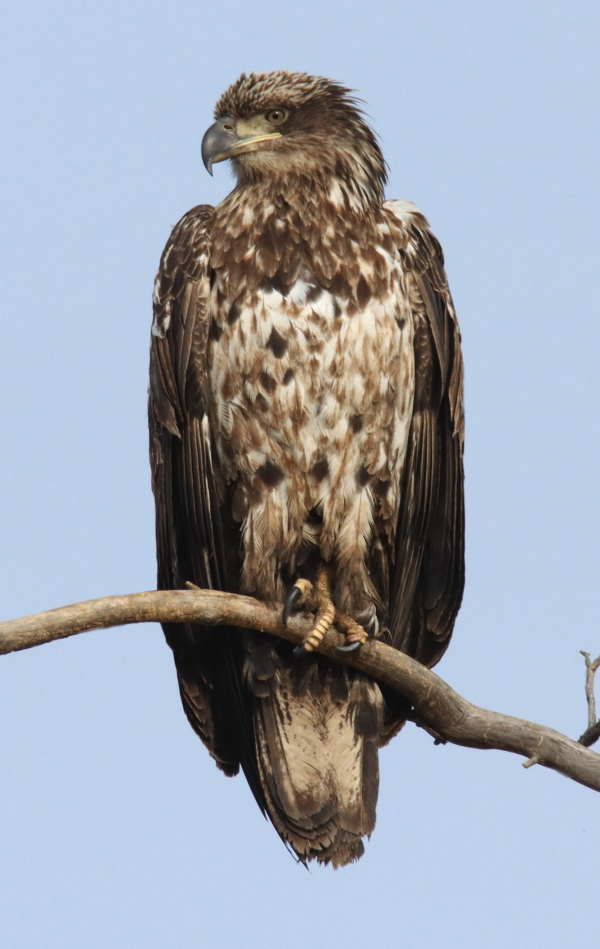
Bald Eagles were the name of the game throughout the week, with hundreds providing exciting observations and some photos of perched and flying individuals.

Photographing immature eagles in flight was emphasized Friday.
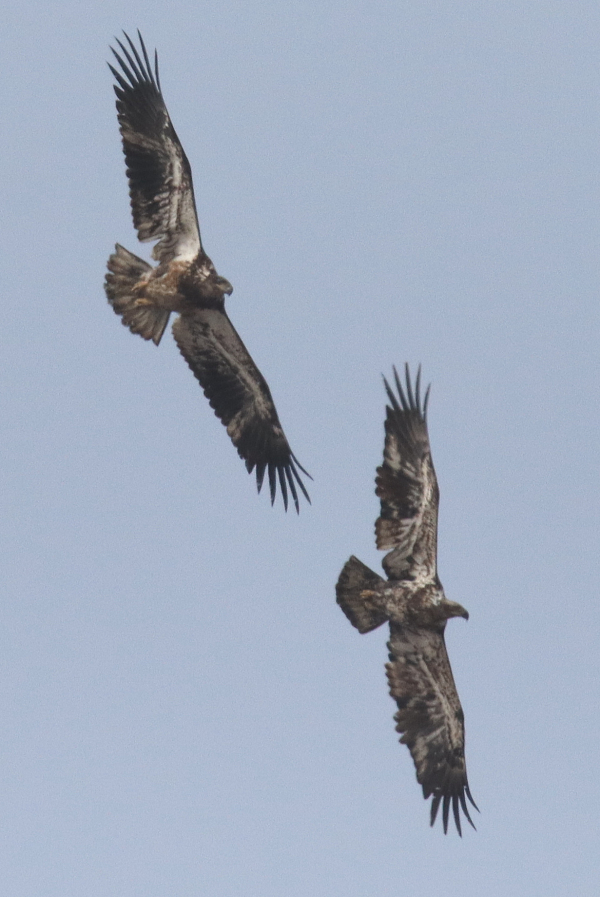
It was especially fun to watch eagles flying together, sometimes in tandem, sometimes as more of a chase sequence, even turning over in flight and extending their talons at times.
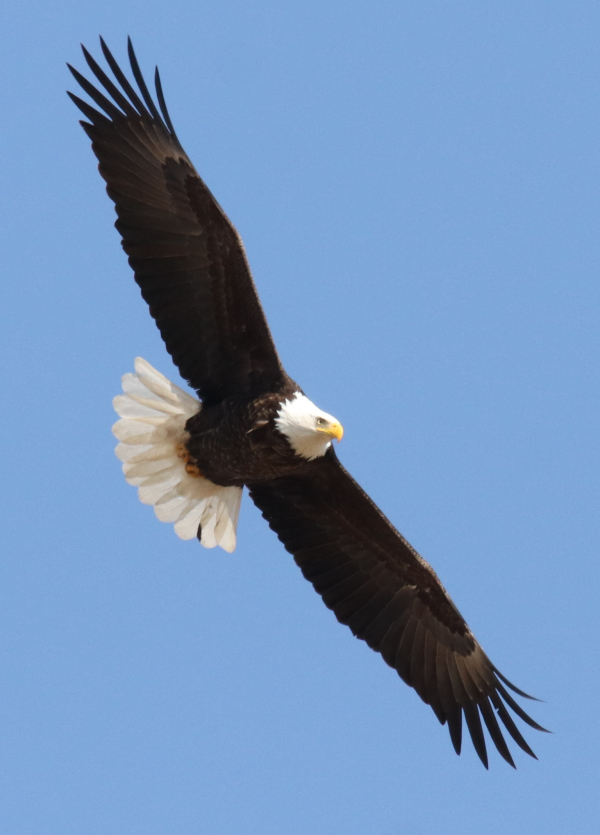
Is there anything more majestic than an adult Bald Eagle slicing across a clear blue sky on a spring day?
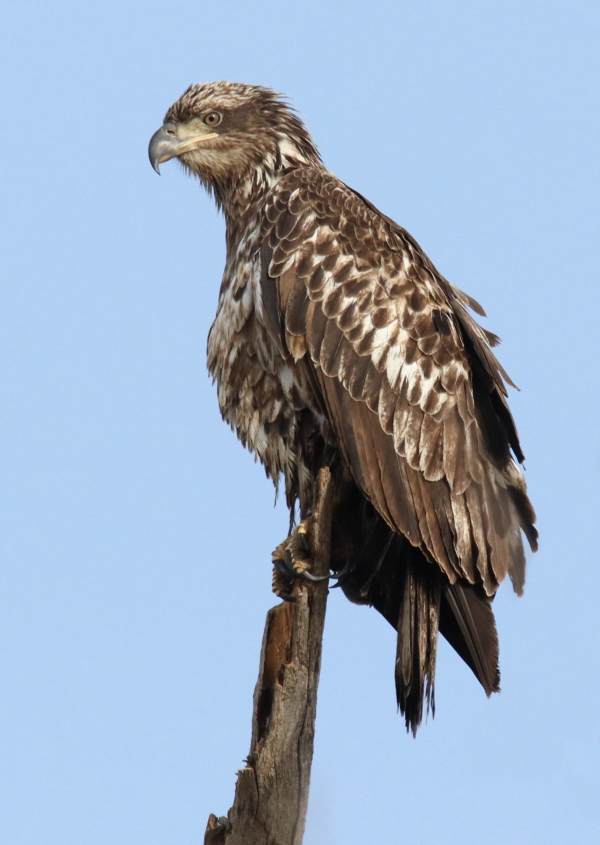
By Monday eagle numbers were noticeably fewer, but still numbering in the hundreds, with a higher percentage of immature eagles in the mix. It appeared the attraction for the concentration of eagles was a winter kill of small fish, which also attracted many Ring-billed Gulls.
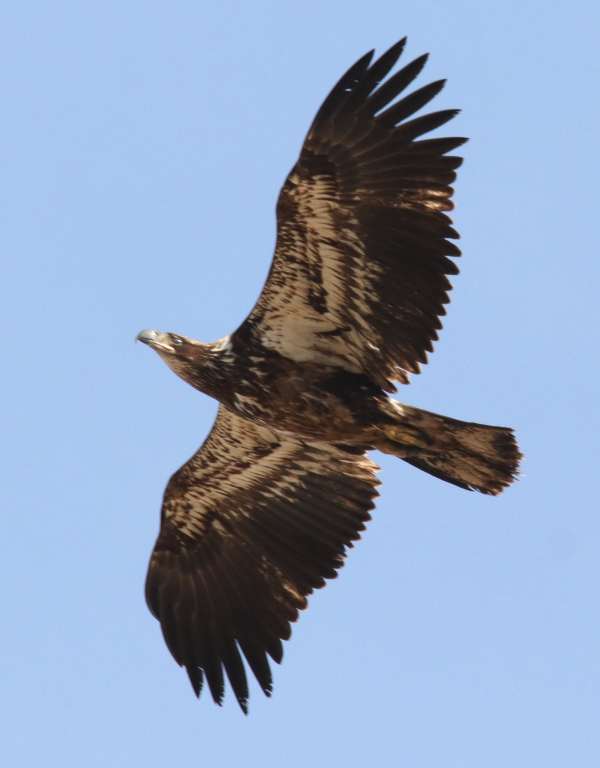
It was especially interesting to photograph the variety of plumage types among immature Bald Eagles, as well as to see individual variations, such as this yearling Bald Eagle with a darker shade of plumage.
|
618 Bald Eagles! Seriously, can you believe it?! It started out with a simple sighting of 3, then 4 Bald Eagles south of Hecla, South Dakota, but a split-second later I realized there were many, many more eagles in adjacent trees and in flight ahead. There were no less than 87 eagles that I could see in an area less than a mile long, with the birds in flight reaching from the tree tops to hundreds of feet overhead, soaring in circular patterns that conjured images of an eagle kaleidoscope as at least 34 were soaring directly above me. But that was just the beginning, with 14 more eagles perched on snags in Hecla Marsh, and many more to the north.
About 4 miles north of the little town of Hecla, and a mile north of the border that divides the Dakotas was a long marsh where I’ve seen 88 Bald Eagles concentrated about this time of March a few years ago. As I approached that marsh, I could see a few eagles perched in trees that lined the far side of the wetland, and when I came to a turnoff I stopped to assess the area for eagles and waterfowl, and while there were obviously many, many eagles perched in trees, there was what appeared to be a scattered flock of geese standing on the ice in the midst of the marsh – but they were not geese, they were Bald Eagles, hundreds of them!
I quickly took an overview look at the scene with binoculars and was amazed at what I saw, with eagles perched in trees, standing along the ice-free shoreline and on the ice in mind-boggling numbers, with more eagles flying low over the ice, patrolling the shore, gliding above the trees, and landing in the trees as other were taking flight from their perches – it was an eagle festival, and I was the only human attendee! When I began counting, I started with the eagles perched in the trees, which numbered 199 – woo-wee! But the eagles on the ice far outnumbered that, totaling 304! And I counted 14 eagles in the air for a total of 517! Add to that the 101 eagles closer to Hecla¸ and the grand total for the borderland area was 618!
The only thing that could dampen the excitement of that hour was the light sprinkles of rain and remarkably overcast sky, but with a north wind blowing, there wouldn’t be much of an out-migration, so I would return for a sunnier photo session. WoW, what a surprise; what an experience! I was actually on my way to Minneapolis, but I had the whole afternoon to enjoy checking out the migration action from the Missouri Coteau where I live across the James and Red Rivers, and into the western edge of the eastern forest in central Minnesota before dark.
Closest to home, as I was just getting started, a beautiful silver male Merlin was perched in the cottonwood tree that stands on the southwest corner of Melody’s Marsh, less than a mile south of home. The marsh also held new flocks of Canvasbacks mixed with Lesser Scaup, along with smaller flocks of Redheads and pairs of Mallards. I observed more flocks of Canvasbacks and scaup, Ring-necked Ducks, and some scattered Common Goldeneyes and Common Mergansers during the initial 10 miles, but there was little avian action after that.
When I made my first deviation off course to drive through Sand Lake National Wildlife Refuge, there were some large flocks of Redheads and Lesser Scaup, a pair of Hooded Mergansers, and scattered Mallards and Canada Geese, along with a lone Bald Eagle. But it appeared the clouds of geese and most flocks of migrating ducks appeared to have cleared out, which wasn’t surprising, and that information was part of the reason I was making some side routes to regional hotspots – to check the pulse of migration. On my way back to North Dakota’s Highway 11, I planned to check on Hecla Marsh and the borderland marshes to see what birds I would find, and even before reaching Hecla Marsh, the Bald Eagle extravaganza began – what a thrill!
Hecla Marsh had some open water, which attracted flocks of Redheads and Lesser Scaup, some pairs of Mallards, and what appeared to be the first Great Blue Heron to arrive at the nesting rookery there. Of course, there were the aforementioned 14 Bald Eagles, all immatures, including 2 that were making a spirited chase flight low above a section of the marsh. The borderland marshes were remarkably dry, with only a few central areas of water remaining, but they were filled with flocks of Green-winged Teal, and a few early Killdeer patrolled the edges.
There were 4 more Bald Eagles scattered along the way to Tewaukon National Wildlife Refuge, where my brother Jim had observed thousands of Snow Geese the previous Saturday. A dozen miles before reaching the little town of Cayuga (where you turn south to the refuge), flocks of geese began showing but they were mostly composed of White-fronted Geese. The primary refuge lake held a large flock of Snow Geese with small flocks leaving by the minute on flights to an area field to feed. There were also some nice flocks of Ring-necked Ducks and separate flocks of Lesser Scaup.
Minnesota Aves
Crossing into the third state of the day, and the first non-Dakota state, a flock of 12 Trumpeter Swans was flying north along the Pomme de Terre River east of Elbow Lake as the sun dipped below the horizon. A mile or so down the highway a group of 16 Bald Eagles was concentrated in a grove of trees on the edge of a large marsh, apparently to roost there overnight. If we add All the Bald Eagles observed Wednesday, it came to a whopping 639 Bald Eagles!
The next morning I spent an hour driving familiar roads that meander through the Lake Minnetonka area west of Minneapolis, hoping for more eagle action combined with the usual Common Mergansers that assemble in big flocks as the lake ice recedes, and maybe some early Wood Ducks or Ospreys. Although there were no mergansers or Woodies, there were occasional Mallard pairs, a group of 3 immature Bald Eagles, a pair of Trumpeter Swans, a Red-tailed Hawk, and an early Osprey!
Next stop was my niece and nephews’ home in Minnesota, north of Minneapolis, where Katy, Jeff, and Anders live. Anders is just learning to walk, but has been pointing out the pair of Sandhill Cranes that returned to their neighborhood the previous week, along with a pair of Mallard Ducks, a cottontail, and gray squirrels – anything he notices out the windows that are conveniently low for him to look outside. A Northern Cardinal was singing as I arrived, and although the cranes didn’t show this time, a local Wild Turkey gobbler ran toward me at the stop sign down the street where it put on a full display and gobbled a couple times – gracias amigo.
Local Action
In spite of a strong north wind and a storm on the way, there seemed to be something of a migration happening Friday; in my area is was indicated by small flocks of Western Meadowlarks, more Northern Harriers, the first Double-crested Cormorants and American Coots, and 3 groups of Tundra Swans numbering 7, 19, and 2. There were also 2 pairs of Buffleheads and a pair of Northern Shovelers, the first of the year, along with more flocks of Canvasbacks, Ring-necked Ducks, Canvasbacks, Lesser Scaup, and Northern Pintails. Only small flocks of Snow Geese were present, with the former clouds of Snows likely moving on, but Cackling Geese and White-fronts persisted in similar numbers.
Across the Drift Plain to the James River (about 50 miles), there were obvious movements of American Kestrels, Killdeer, Sharp-shinned Hawks, Green-winged Teal, robins, grackles, and Red-winged Blackbirds. Of course, I had to return to the Bald Eagle festival as soon as possible, so ignoring office duties, I headed back with the hope that the sun would break through the clouds enough for me to get a few photos of eagles. With a spring storm on the way, the sun wouldn’t show through until Monday, and there were still hundreds of eagles on hand, and I had some fun photographing at a grove of tree that I refer to as eagle flight center, which I describe in the illustrated Bird Photography feature in this issue.
Other raptors I observed along the hour-long drive to the borderlands hotspot, were 21 American Kestrels, 12 Red-tailed Hawks, 9 Northern Harriers, and 2 Bald Eagles together, an adult with an immature. Plus closer to home I spied a dark morph Rough-legged Hawk, in the same field as a normally colored female or immature Rough-leg – both on the hunt. That’s 46 raptors in addition to the hundreds of Bald Eagles in the Hecla area adjacent to the James River.
Snow Geese were non-existent over the weekend, although Monday about 60 were mixed among 3 flocks of about 100 White-fronted and Cackling Geese less than a half-mile away from my desk at Melody’s Marsh. There were also a few pairs of Canada Geese, plus Redheads, Mallards, and Ring-billed Gulls. Monday’s new birds were 6 White Pelicans and 3 Greater Yellowlegs – the last shorebirds to leave last fall were the first to return this spring. However, the Yellowlegs and Killdeer were probably taken by surprise by the April Fools’ snowfall Tuesday, although the white precipitation melts quickly to nurture budding trees. Enjoy your week, and keep in mind: You never know what’s around the next corner – it might even be hundreds of eagles! I’m finishing this issue on the first day of April with great excitement for the month ahead – Enjoy the birds around you.
Article and Photos by Paul Konrad
Share your bird sightings and photographs at editorstbw2@gmail.com